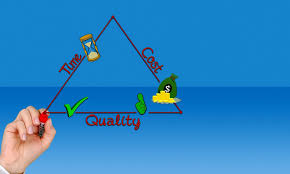
How Project Managers manage the interaction of scope, time, and cost
All projects run the risk of suffering from triple constraint. If the elements of the triple constraint are not kept in check, then the project will fail. In this article, you’ll learn why an experienced Project Manager won’t discuss one element of the triple constraint without discussing the other two.
What is the triple constraint?
There are three key elements that constrain a project:
1. Project scope
This is the deliverables of the project. This is defined in the Project Scope document, and is identified in the earliest stages of the project. Unless the project scope is defined, the Project Manager and Project Team cannot be expected to be successful – how do they know what is required of them?
2. Time
This is the actual time that the project is set to take, defining when the project deliverables should be delivered. The time required is directly related to the project scope and project cost.
3. Project cost
Project cost is the estimate of the total cost to complete the project on time, producing the deliverables to the quality expected.
The triangular nature of the triple constraint
The triple constraint says that the project is impacted by scope, cost and time. If you wish to alter one, the change directly impacts the other two. Thus, should the customer wish to redefine one of the elements of the triple constraints, the Project Manager will discuss the other two.
For example, let’s say that a project has started, and the customer decides that the completion date must be brought forward by two weeks. This may only be possible if:
- More money is provided to pay for the extra resources required to speed up delivery of the project’s products
- The quality or quantity (or both) of the project’s products, as defined in the project scope, are reduced
Redefinition of a project is always a negotiation
Should a customer wish to redefine any of the elements of the triple constraint, it will inevitably lead to a negotiation about the other two elements. The triple constraint model helps this negotiation, by defining the trade-offs that will be needed. In PRINCE2, these negotiations are part of project progression under PRINCE2’s management stages.
As the project progresses, management stages allow the Project Manager to identify issues and adjust to prevent these issues from causing irreparable consequences for the project.
Three triple constraint competencies a Project Manager must have
There are three competencies that a customer should expect from a Project Manager with regards to the triple constraint.
a) Understanding of the triple constraint
First, they should be able to display an understanding of how project scope, time and cost interact and how each affects the other. The Project Manager must accept that altering one of these elements will have repercussions for the other elements, creating issues further along the project timeline.
b) Communicating the triple constraint
Second, the Project Manager should communicate how the triple constraint affects the project, to all project stakeholders. This will help ensure that scope, time and cost are fully considered before project initiation.
“Forewarned is forearmed,” as they say. Project stakeholders who have had the triple constraint explained explicitly should not be surprised if they make a change to the project scope and the Project Manager then explains that this will mean the project takes longer and will cost more.
c) Monitoring the triple constraint
The Project Manager must employ a methodical approach to managing a project that ensures the triple constraint is monitored throughout the project timeline. This includes redefinitions of the elements of the triple constraint, whether these redefinitions are because of unexpected events or customer requests.
In summary
The triple constraint explains the mechanism by which scope, time and cost interact with each other to determine project success. It is important that all project stakeholders are made aware of this interaction early in the project. Communicating this is one of the responsibilities of the Project Manager – understanding of the triple constraint by all is imperative to gain a clear definition of project deliverables and ensure proper due diligence is completed ahead of starting a project.
To discover how focused project management using PRINCE2 methodology can help your project be successful, contact Your Project Manager:

